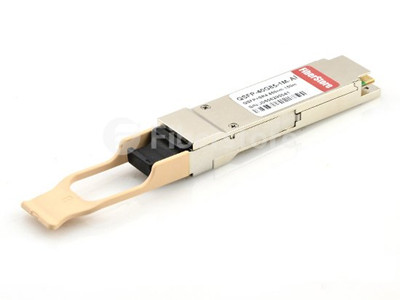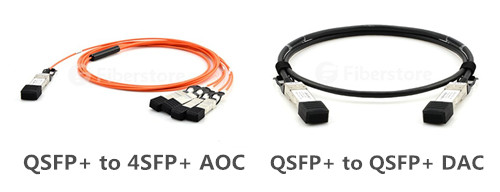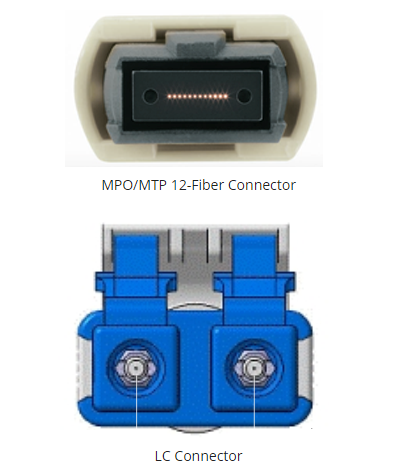2010 witnessed the ratification of 40GbE and 100GbE standard, which is a great breakthrough of telecommunication industry. This standard is developed by the IEEE 802.3ba Task Force to support sending Ethernet frames at 40 and 100 gigabits per second. They also address physical layer specifications for communication across backplanes, copper cabling, multimode fiber and single-mode fiber. In 2016, 40GbE will continue to enjoy its popularity of aggregation links in data center networks. With four times the capacity and the ability to cost-effectively migrate to 100GbE, 40GbE is regarded as the next logical step in the evolution of data network. 40GbE has been utilized worldwide, and 100GbE will become popular soon, we can’t help looking forward to the advent of higher-bandwidth network like 400GbE.
A Closer Look at 40GbE
40GbE network, just like 1GbE or 10GbE network layer, is mainly comprising of a pair of transceivers connected by a cable. The transceivers, in turn, are plugged into either network servers or a variety of components including interface cards and switches. The next part will provide some detailed information about these components of 40GbE network.
40GbE network, just like 1GbE or 10GbE network layer, is mainly comprising of a pair of transceivers connected by a cable. The transceivers, in turn, are plugged into either network servers or a variety of components including interface cards and switches. The next part will provide some detailed information about these components of 40GbE network.
40GbE Optical Transceiver
40GbE transceivers are being developed along several standard form factors. Of all the 40G transceivers, the QSFP (quad small-form-factor pluggable) is the most commonly used 40G transceiver module on the market for its similar size to the CXP and providing four transmit and four receive lanes to support 40GbE applications for optical fiber and copper cables. Engineers anticipate that when lane rates increase to 25Gb/s, the future role for QSFP may be to serve 100GE. The following picture shows a Arista QSFP-40G-SR4 transceiver module.
40GbE transceivers are being developed along several standard form factors. Of all the 40G transceivers, the QSFP (quad small-form-factor pluggable) is the most commonly used 40G transceiver module on the market for its similar size to the CXP and providing four transmit and four receive lanes to support 40GbE applications for optical fiber and copper cables. Engineers anticipate that when lane rates increase to 25Gb/s, the future role for QSFP may be to serve 100GE. The following picture shows a Arista QSFP-40G-SR4 transceiver module.

40GbE Cabling
Cabling for 40GbE, summarized in the previous passage, can be optical fiber or copper. The supportable channel length depends on the cable and the transceiver type. Transceivers to send light across fiber are reassuringly expensive, the higher the bandwidth and the longer the distance required, the pricier the module. There are two basic cabling options for 40G network—DAC or AOC. For the passive and active direct-attach copper (DAC) cables, it allows lower-cost short-reach capability for top-of-rack (ToR)-to-server connectivity. However, DAC cables are limited to transmission distance, and coaxial cable can be stiff and bulky in high-density deployments. Active optical cable (AOC) allows lower-cost short-reach capacity with more flexible cabling but reconfigurations of length or failed transceiver requires replacement of entire assembly. The following image shows a QSFP-4X10G-AOC10M (left) and QSFP-H40G-CU5M (right).
Cabling for 40GbE, summarized in the previous passage, can be optical fiber or copper. The supportable channel length depends on the cable and the transceiver type. Transceivers to send light across fiber are reassuringly expensive, the higher the bandwidth and the longer the distance required, the pricier the module. There are two basic cabling options for 40G network—DAC or AOC. For the passive and active direct-attach copper (DAC) cables, it allows lower-cost short-reach capability for top-of-rack (ToR)-to-server connectivity. However, DAC cables are limited to transmission distance, and coaxial cable can be stiff and bulky in high-density deployments. Active optical cable (AOC) allows lower-cost short-reach capacity with more flexible cabling but reconfigurations of length or failed transceiver requires replacement of entire assembly. The following image shows a QSFP-4X10G-AOC10M (left) and QSFP-H40G-CU5M (right).

Connector Type
With regards to connectors, the significant change from 10G to 40G is the use of MPO (Multi-Fiber Push On) type connectors at the multimode transceivers to support the multi-fiber parallel optics channels. The traditional LC duplex connector that SFP+ modules use has a ceramic ferrule on each connector, which is aligned in an adapter panel with the use of a ceramic alignment sleeve. However, the MTP/MPO connector uses a pinned and non-pinned connector alignment system, making it imperative to always maintain the correct pinning. For data center environments operating at 40GbE or 100GbE, OM3 and OM4 multimode cabling is generally recommended because its reach supports a wider range of deployment configurations compared to copper solutions, and the cost is lower compared to single-mode solutions.
With regards to connectors, the significant change from 10G to 40G is the use of MPO (Multi-Fiber Push On) type connectors at the multimode transceivers to support the multi-fiber parallel optics channels. The traditional LC duplex connector that SFP+ modules use has a ceramic ferrule on each connector, which is aligned in an adapter panel with the use of a ceramic alignment sleeve. However, the MTP/MPO connector uses a pinned and non-pinned connector alignment system, making it imperative to always maintain the correct pinning. For data center environments operating at 40GbE or 100GbE, OM3 and OM4 multimode cabling is generally recommended because its reach supports a wider range of deployment configurations compared to copper solutions, and the cost is lower compared to single-mode solutions.

Use Parallel Optics
Traditionally, the Ethernet standard preferred to use duplex fiber cabling with each channel using one fiber to transmit and the other to receive. However, the 802.3ab standard requires multiple lanes of traffic per channel. To realize this, the 40/100GbE standard uses parallel optics. For example, the 40GbE specification calls for a 12-fiber cabling solution with each channel featuring four dedicated transmit fibers and four dedicated receive fibers. The middle four fibers remain unused, or dark. While the 100GbE solution specifies 24 fibers divided into two 12-fiber arrays with one array dedicated to transmit and the other dedicated to receive. In each array, the middle ten fibers are dedicated to traffic while the two fibers on either end remain dark.
Traditionally, the Ethernet standard preferred to use duplex fiber cabling with each channel using one fiber to transmit and the other to receive. However, the 802.3ab standard requires multiple lanes of traffic per channel. To realize this, the 40/100GbE standard uses parallel optics. For example, the 40GbE specification calls for a 12-fiber cabling solution with each channel featuring four dedicated transmit fibers and four dedicated receive fibers. The middle four fibers remain unused, or dark. While the 100GbE solution specifies 24 fibers divided into two 12-fiber arrays with one array dedicated to transmit and the other dedicated to receive. In each array, the middle ten fibers are dedicated to traffic while the two fibers on either end remain dark.
Conclusion
The ratification of 40GbE/100GbE Ethernet standard is not only the breakthrough of telecom industry, but a good news for human beings for helping people to lead a better digital life. Installing 40GbE network has been proven to be a cost-effective method. By simply deploying a CFP form factor transceiver, then you can enjoy the fast internet speed of 100GbE. 40GbE and 100GbE has already upon us, can 400GbE be far behind. Fiberstore offers a variety of 40G devices including 40G QSFP+ and 40G cables. They also have CFP, CFP2 and CFP4 in stock.
The ratification of 40GbE/100GbE Ethernet standard is not only the breakthrough of telecom industry, but a good news for human beings for helping people to lead a better digital life. Installing 40GbE network has been proven to be a cost-effective method. By simply deploying a CFP form factor transceiver, then you can enjoy the fast internet speed of 100GbE. 40GbE and 100GbE has already upon us, can 400GbE be far behind. Fiberstore offers a variety of 40G devices including 40G QSFP+ and 40G cables. They also have CFP, CFP2 and CFP4 in stock.
评论
发表评论